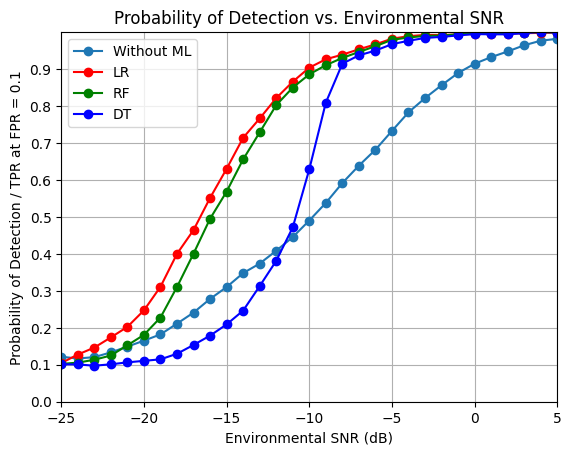This project dives into Rayleigh fading channels for Non-Orthogonal Multiple Access (NOMA) users. 📡 Leveraging Monte Carlo simulations, it explores signal detection across different Signal-to-Noise Ratios (SNRs). 📊 Plus, we harness the power of Machine Learning to boost signal detection capabilities.
- numpy: For number crunching 🔢.
- pandas: Expert at data handling and manipulation 📈.
- matplotlib: Our go-to for stunning visualizations and plots 📊.
- scipy: A powerhouse for scientific computing, essential for interpolation 🔬.
- scikit-learn: The brain behind our Machine Learning models 🤖.
- Monte Carlo iterations:
num_iter = 10000 - NOMA users:
N = 2 - Power allocations:
a1, a2 = 0.8, 0.2 - Sampled length:
S = 4096 - False-alarm probability:
Pf = 0.1 - Environmental SNR range: -25dB to 5dB 🔉.
- Transmitter power:
transmitter_power = 1
Utilizing the Monte Carlo simulation, we:
- Craft NOMA signals with random cyclic delays 🔄.
- Merge these to form our transmitted signal 📶.
- Stir in Rayleigh distributed noise for realism 🌪️.
- Detect NOMA signals with cyclic correlation 🔍.
We train three ML champions:
- Logistic Regression (LR)
- Random Forest (RF)
- Decision Tree (DT)
They're on a mission to spot NOMA signals. We assess their prowess using the ROC curve, eyeing the True Positive Rate (TPR) against a False Positive Rate (FPR) of 0.1.
We plot Detection Probability vs. Environmental SNR, showcasing:
- Classic signal detection (sans ML) 🚦
- Logistic Regression (LR) 📈
- Random Forest (RF) 🌳
- Decision Tree (DT) 🌲
- Clone our repository using
git clone https://github.com/suyashvsingh/NOMA-ML-Spectrum-Detection-CIoT.git📂. - Install the dependencies using
pip install -r requirements.txt📦. - Fire up the notebook for an epic plot showdown: traditional vs ML-augmented detection under varied SNRs 📉.
A stunning graph, "Probability of Detection vs. Environmental SNR," awaits you. It pits traditional detection against our ML trio, LR, RF, and DT, focusing on TPR at a steady FPR of 0.1.
Jump into:
- Turbocharge the Monte Carlo simulation ⚙️.
- Bring in cutting-edge ML algorithms 🧠.
- Elevate our visualization game 🎨.
Note: For the whole story and deep insights, explore the notebook 📘.

